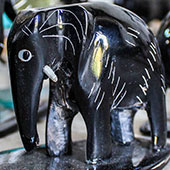Design Resource
Horn Craft - Cuttack, Orissa
Anatomy of Bird or Animal
by
Prof. Bibhudutta Baral and Bhargava A. J.
Making Process of Horn Craft is as follows:
• Depending on the type of final product required suitable type of horn is selected and work is started. Generally buffalo horn is used for the process of carving. Deer’s horns aren’t used in the process of carving they are mainly used as obtained.
• Once a horn is selected then it is roughly sawed for a flattened top. Then using a hammer and a chisel one end of the horn is made slimmer to insert into the motor shaft for turning process to cut the horn to a desired length.
• The horn is then shaped using the sharp tips of the files. Once after making any kind of a change to the artifact it has to be inspected. And then the carving process can be continued.
• Once the carving process is completed sandpaper is used for buffing the artifact, after which a wet leaf is used to clean and smoothen the artifact.
• Charcoal is mixed with water and is then applied to the artifact which fills up all the small gaps on the artifact making it look jet black.
• Using a clean piece of cloth the artifact is then dried and removed from the motor.
• If required painting is done now along with other fine details. After this, the product is ready for sale.
• In the case of artifacts, which are made of many different pieces, they are all sculpted, detailed, polished and painted separately and once all the separate pieces are ready they are then glued together and are set aside to dry.
• Artifacts, which include flattened pieces like the wings of the birds and the fishes are all made of hollow horns, as they are translucent and give out beautiful colours and look like finished products.















